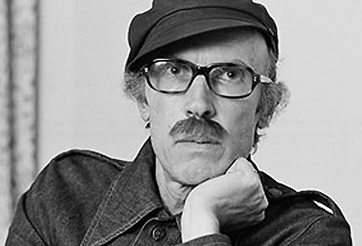 
Eric Rohmer by Derek Schilling
If you're curious about Rohmer, this well-researched guide provides thoughtful analysis of his work and themes.
Explore this book:
 
The Taste for Beauty by Eric Rohmer
A collection of Rohmer's essays for Cahiers du Cinema, written between 1948 and 1977. Dealing with the fundamental and theoretical questions of filmmaking, it is a must read for all fans of the Nouvelle Vague.
Explore this book:
Crisp, dean of humanities at Australia's Griffth University, presents a succinct and perceptive study suitable for laymen and cineasts alike.
Explore this book:
|
Eric Rohmer (born Jean-Marie Maurice Scherer, April 4, 1920 - January 11, 2010) was a screenwriter and director and a key figure in French New Wave cinema. He began writing film criticism in the late 1940’s and was, for some years, the editor of Cahiers du Cinema. He was the last of the major New Wave directors to become established, working at Cahiers du Cinema and in television, before achieving international success in the late 1960’s. |
|
|

Dir. Eric Rohmer
|
|
Born Jean-Marie Maurice Scherer in 1920 in Nancy, a small town in Lorraine, Rohmer later moved to Paris, where he worked as a literature teacher and newspaper reporter. In 1946, under the pen name Gilbert Cordier, he published a novel titled, Elizabeth. Soon after, he began to focus on film criticism publishing two seminal articles in 1948: “Cinema, the Art of Space,” in Revue du Cinema, and “For a Talking Cinema,” in Les Temps Modernes. Both articles established the theoretical foundations that would guide his later criticism and film-making, as well as being highly influential on other directors of the New Wave.
As a regular at the Cinematheque Francais he came into contact with Francois Truffaut, Jacques Rivette, Claude Chabrol, and Jean-Luc Godard. Around this time he adopted the pseudonym of Eric Rohmer, an amalgam of names of the director Erich Von Stroheim, and the author of the Fu Manchu stories, Sax Rohmer.
In 1950, he set up the short lived Gazette du Cinema with Godard and Rivette, before Jacques Doniol-Valcroze and Andre Bazin invited him to write for Cahiers du Cinema. At Cahiers, Rohmer helped develop the theory of auteurism, and echoed Bazin in praising long takes and the kind of camerawork that did not interfere with the presentation of events. He wrote: “The cinema is a privileged art form because it most faithfully transcribes the beauty of the real world. Art can never improve on reality.”
Also in 1950, Rohmer made his first 16mm short film, Journal d’un Scelerat (A Villain’s Diary). Two years later, he began filming his debut feature film Les Petites Filles Modeles (Perfect Little Girls), but this was abandoned before it was completed. Rohmer continued making shorts through the 50’s in collaboration with friends such as Paul Gegauff, Jacques Rivette, editor Agnes Guillemot, and Jean-Luc Godard. He wrote the screenplay for Godard’s Tous les Garcons S’Appellent Patrick (All the Boys are Called Patrick, 1957).
In 1956, Rohmer assumed editorial control of Cahiers du Cinema, a position he held for the next seven years. The following year, he co-wrote with Claude Chabrol, Hitchcock, the first serious appraisal of the director’s work. The book was a model of auteur criticism, combining detailed narrative analysis with great attention to technique.
After directing one more short, Veronique et Son Cancre (Veronique and Her Dunce, 1958), Rohmer made his first feature, Le Sign du Lion (The Sign of Leo, 1959), through Claude Chabrol’s AJYM productions. Shot on location in and around Paris over seven weeks, the film tells the story of an impoverished musician who is forced to spend time living on the streets after failing to receive an expected inheritance. Low key and slow moving, the picture had disappointing screenings and wasn’t released commercially until 1962, when it failed to recoup any money.
Meanwhile, Rohmer’s authority at Cahiers was beginning to deteriorate as Rivette, Doniol-Valcroze, and Truffaut began to pressure him to open up the critical range of the journal. Some of the recent New Wave films were being attacked by rival magazine Positif and other mainstream publications, and Truffaut, complained that Cahiers was too busy praising commercial American movies, when it should be defending challenging new French films. Doniol-Valcroze pressed for more political commentary in the magazine and an expanded range of films reviewed, including documentaries and Third World cinema.
Rohmer, however, refused to revise his aesthetic criteria and was eventually ousted by Doniol-Valcroze, who controlled the money and rallied most of the staff behind him. Suddenly, he found himself without a job or career just as his former colleagues were finding international acclaim as directors. Through friends and admirers, he managed to get a job working for ORTF, the national radio and television unit, where he worked for some years directing over a dozen films including profiles of Lumiere and Dreyer for the Filmmakers of our Time series, as well as other documentaries on such diffuse subjects as the Parsifal legend, the Industrial Revolution, and the lives of Paris's female student population.
In 1962, the year before he left Cahiers, Rohmer was approached by an enthusiastic young cinephile named Barbet Schroeder who had set up his own production company, Les Films du Losange, with money from his parents. Schroeder greatly admired Rohmer and offered to produce a short film, La Boulangere de Monceau (The Girl at the Monceau Bakery, 1963), through the company. This would become the first of the “Six Moral Tales”, which would become the focus of Rohmer’s output over the next ten years.
Over the following years, Rohmer continued to collaborate with Shroeder, making a second short moral tale, La Carriere de Suzanne (Suzanne’s Career, 1963), and contributing an episode to the New Wave compilation Paris Vu Par (1964). Finally, in 1966, Rohmer completed La Collectioneuse (The Collector), the third of the Six Moral Tales and the first shot in colour. The film won the Silver Bear award at the Berlin Film Festival, helping to establish Rohmer’s international reputation, as well as the financial success of Les Films du Losange.
Even greater success came with the next instalment of the Moral Tales, 1969’s Ma Nuit Chez Maud (My Night With Maud). Starring Jean-Louis Trintignant as a man who, on the eve of his marriage, is left alone with a beautiful divorcee and is forced to test his principles.It garnered Oscar nominations for Best Foreign Language Picture and Best Screenplay and become something of a hit in America. This was followed by the final parts in the series, Le Genou de Claire (Claire’s Knee, 1970), and Amour L’Apres-Midi (Love in the Afternoon, 1972). Both were about characters facing a mid-life crisis who are forced to make a moral decision, and both were critical successes across the world. Rohmer now had a small but loyal following.
Following the Moral Tales, Rohmer made two period films: Die Marquis von O... (1976), from a novella by Heinrich von Kliest, and Percival Le Gallois (1978), based on a 12th century manuscript by Chretien de Troyes. Though now considered amongst his finest films, Percival, which featured actors speaking in verse, was his least typical work, and failed to find much success with audiences.
Rohmer returned to contemporary material with 1981’s La Femme de L’Aviateur, the first of a new six film series dubbed Comedies and Proverbs. The films in this series shone a revealing, and often humorous light, on French middle-class society in the 1980’s. Recurrent themes included infidelity, promiscuity and
the search for love. The most popular of these were the comedy Pauline a la Plage (1983) about the conflicting desires of various characters on a summer holiday, and the poetically wistful Le Rayon Vert (The Green Ray, 1986), which won the director the Golden Lion award at the Venice Film Festival in 1986.
In the 1990’s Rohmer worked on a third series, the Tales of the Four Seasons, which included Conte de Printemps (1990), Conte d’Hiver (1992), Conte d’Ete (1996), and Conte d’Automne (1998). Each of these four films is set at a different time of the year corresponding with a different season. The central character in each film is coping with a recent emotional crisis and the films ends optimistically, looking forward to a more hopeful future.
Rohmer’s next film, L’Anglaise et le Duc (The Lady and the Duke, 2001) was another surprising departure. This historical drama, set at the time of the French revolution, used cutting-edge digital technology, with actors embeded into painted backdrops. This was followed by Triple Agent (2005) set on the eve of the Second World War, and his final film, Les Amours d’Astree at de Celadon (2007), based on a 17th century work by Honore d’Urfe.
In a career lasting over fifty years, Eric Rohmer remained remarkably faithful to the theoretical opinions he developed as a young critic, applying them consistently to all areas of his productions. He always relied strictly on an existing reality, avoiding close-ups, non-diegetic music, and any other cinematic devices he viewed as artificial. While some have criticised his films as being slow-moving and wordy, others have been enthralled by his subtle and absorbing character studies. Throughout his career, Rohmer proved that a director working on the margins of mainstream cinema could produce an important and highly personal body of work without giving into compromise. He died on January the 11th, 2010 at the age of 89.
As Director
French Title |
English Title |
Year |
Type of Film |
Notes |
| Journal d'un scélérat |
|
1950 |
short |
|
| Présentation ou Charlotte et son steak |
|
1951 |
short |
|
| Les Petites filles modèles |
|
1952 |
feature |
unfinished |
| Bérénice |
|
1954 |
short |
|
| La Sonate à Kreutzer |
|
1956 |
short |
|
| Véronique et son cancre |
Veronique and Her Dunce |
1958 |
short |
|
| Le Signe du lion |
The Sign of Leo |
1962 |
feature |
|
| La Boulangère de Monceau |
The Bakery Girl of Monceau |
1963 |
short |
#1 Contes moreaux (Six Moral Tales), not released theatrically |
| La Carrière de Suzanne |
Suzanne's Career |
1963 |
short |
#2 Contes moreaux (Six Moral Tales), not released theatrically |
| Paysages urbains |
|
1963 |
documentary |
Television documentary for series En Profil dans le texte |
| Les Cabinets de physique au XVIIIème siècle |
|
1964 |
documentary |
Television documentary for series En Profil dans le texte |
| Les Métamorphoses du paysage |
Changing Landscapes |
1964 |
documentary |
Television documentary for series En Profil dans le texte |
| Les salons de Diderot |
|
1964 |
documentary |
Television documentary for series En Profil dans le texte |
| Perceval ou le conte du Graal |
|
1964 |
documentary |
Television documentary for series En Profil dans le texte |
| Nadja à Paris |
|
1964 |
short |
|
| Don Quichotte de Cervantes |
|
1965 |
documentary |
Television documentary for series En Profil dans le texte |
| Les Histoires extraordinaires d'Edgar Poe |
|
1965 |
documentary |
Television documentary for series En Profil dans le texte |
| Les Caractères de La Bruyère |
|
1965 |
documentary |
Television documentary for series En Profil dans le texte |
| Entretien sur Pascal |
|
1965 |
documentary |
Television documentary for series En Profil dans le texte |
| Place de l'Étoile |
|
1965 |
short |
From anthology Paris vu par (Six in Paris) |
| Carl Th. Dreyer |
|
1965 |
documentary |
An episode of the television series Cinéastes de notre temps |
| Le Celluloïd et le marbre |
|
1966 |
documentary |
An episode of the television series Cinéastes de notre temps |
| Victor Hugo, les contemplations |
|
1966 |
documentary |
Television documentary for series En Profil dans le texte |
| Une Étudiante d'aujourd'hui |
|
1966 |
documentary |
|
| La Collectionneuse |
The Collector |
1967 |
feature |
#4 Contes moreaux (Six Moral Tales) |
| L'Homme et la machine |
|
1967 |
documentary |
|
| L'Homme et les images |
|
1967 |
documentary |
|
| Fermière à Montfaucon |
|
1967 |
documentary |
|
| L'Homme et les frontières |
|
1968 |
documentary |
|
| L'Homme et les gouvernements |
|
1968 |
documentary |
|
| Entretien avec Mallarmé |
|
1968 |
documentary |
Television documentary for series En Profil dans le texte |
| Nancy au XVIIIe siècle |
|
1968 |
documentary |
Television documentary for series En Profil dans le texte |
| Post-face à l'Atalante |
|
1968 |
documentary |
An episode of the television series Aller au cinéma |
| Louis Lumière |
|
1968 |
documentary |
An episode of the television series Aller au cinéma |
| Post-face à Boudu sauvé des eaux |
|
1968 |
documentary |
An episode of the television series Aller au cinéma |
| Ma nuit chez Maud |
|
1969 |
feature |
#3 Contes moreaux (Six Moral Tales), although planned as the third moral
tale, its production was delayed due to the unavailability of actor
Jean-Louis Trintignant and it was released after the fourth tale |
| Victor Hugo architecte |
|
1969 |
documentary |
Television documentary for series En Profil dans le texte |
| La Sorcière de Michelet |
|
1969 |
documentary |
Television documentary for series En Profil dans le texte |
| Le béton dans la ville |
|
1969 |
documentary |
Television documentary for series En Profil dans le texte |
| Le Français langue vivante? |
|
1970 |
documentary |
Television documentary for series En Profil dans le texte |
| Le Genou de Claire |
Claire's Knee |
1970 |
feature |
#5 Contes moreaux (Six Moral Tales) |
| L'Amour l'après-midi |
Love in the Afternoon/Chloe in the Afternoon |
1972 |
feature |
#6 Contes moreaux (Six Moral Tales) |
| Ville nouvelle |
|
1975 |
documentary |
Directed four-part miniseries for television |
| La Marquise d'O... |
The Marquise of O… |
1976 |
feature |
|
| Perceval le Gallois |
Perceval |
1978 |
feature |
|
| Catherine de Heilbronn |
|
1980 |
feature |
Made for television |
| La Femme de l'aviateur |
The Aviator's Wife |
1981 |
feature |
#1 Comédies et Proverbes (Comedies and Proverbs) – "It is
impossible to think about nothing" |
| Le Beau mariage |
A Good Marriage |
1982 |
feature |
#2 Comédies et Proverbes (Comedies and Proverbs) – "Can
anyone refrain from building castles in Spain?" |
| Pauline à la plage |
Pauline at the Beach |
1983 |
feature |
#3 Comédies et Proverbes (Comedies and Proverbs) – "He who
talks too much will hurt himself" |
| Les Nuits de la pleine lune |
Full Moon in Paris |
1984 |
feature |
#4 Comédies et Proverbes (Comedies and Proverbs) – "He who has
two women loses his soul, he who has two houses loses his mind" |
| Le Rayon vert |
The Green Ray/Summer |
1986 |
feature |
#5 Comédies et Proverbes (Comedies and Proverbs) – "Ah, for
the days/that set our hearts ablaze" |
| Bois ton café |
Drink your coffee it's getting cold |
1986 |
short |
|
| Quatre Aventures de Reinette et Mirabelle |
Four Adventures of Reinette and Mirabelle |
1986 |
feature |
|
| L'Ami de mon amie |
My Girlfriend's Boyfriend |
1987 |
feature |
#6 Comédies et Proverbes (Comedies and Proverbs) – "My
friends' friends are my friends" |
| Le Trio en si bémol |
|
1988 |
feature |
|
| Les Jeux de société |
|
1989 |
feature |
Television episode for Histoire de la vie privée |
| Conte de printemps |
A Tale of Springtime |
1990 |
feature |
#1 Contes des quatre saisons (Tales of the Four Seasons) |
| Conte d'hiver |
A Winter's Tale/A Tale of Winter |
1992 |
feature |
#2 Contes des quatre saisons (Tales of the Four Seasons) |
| L'Arbre, le maire et la médiathèque |
The Tree, The Mayor, and the Mediatheque |
1993 |
feature |
|
| Les Rendez-vous de Paris |
Rendezvous in Paris |
1995 |
feature |
|
| Conte d'été |
A Tale of Summer |
1996 |
feature |
#3 Contes des quatre saisons (Tales of the Four Seasons) |
| Conte d'automne |
A Tale of Autumn |
1998 |
feature |
#4 Contes des quatre saisons (Tales of the Four Seasons) |
| L'Anglaise et le duc |
The Lady and the Duke |
2000 |
feature |
|
| Triple Agent |
Triple Agent |
2004 |
feature |
|
| Le Canapé rouge |
|
2004 |
short |
|
| Les Amours d'Astrée et de Céladon |
The Romance of Astrea and Celadon |
2007 |
feature |
|
|